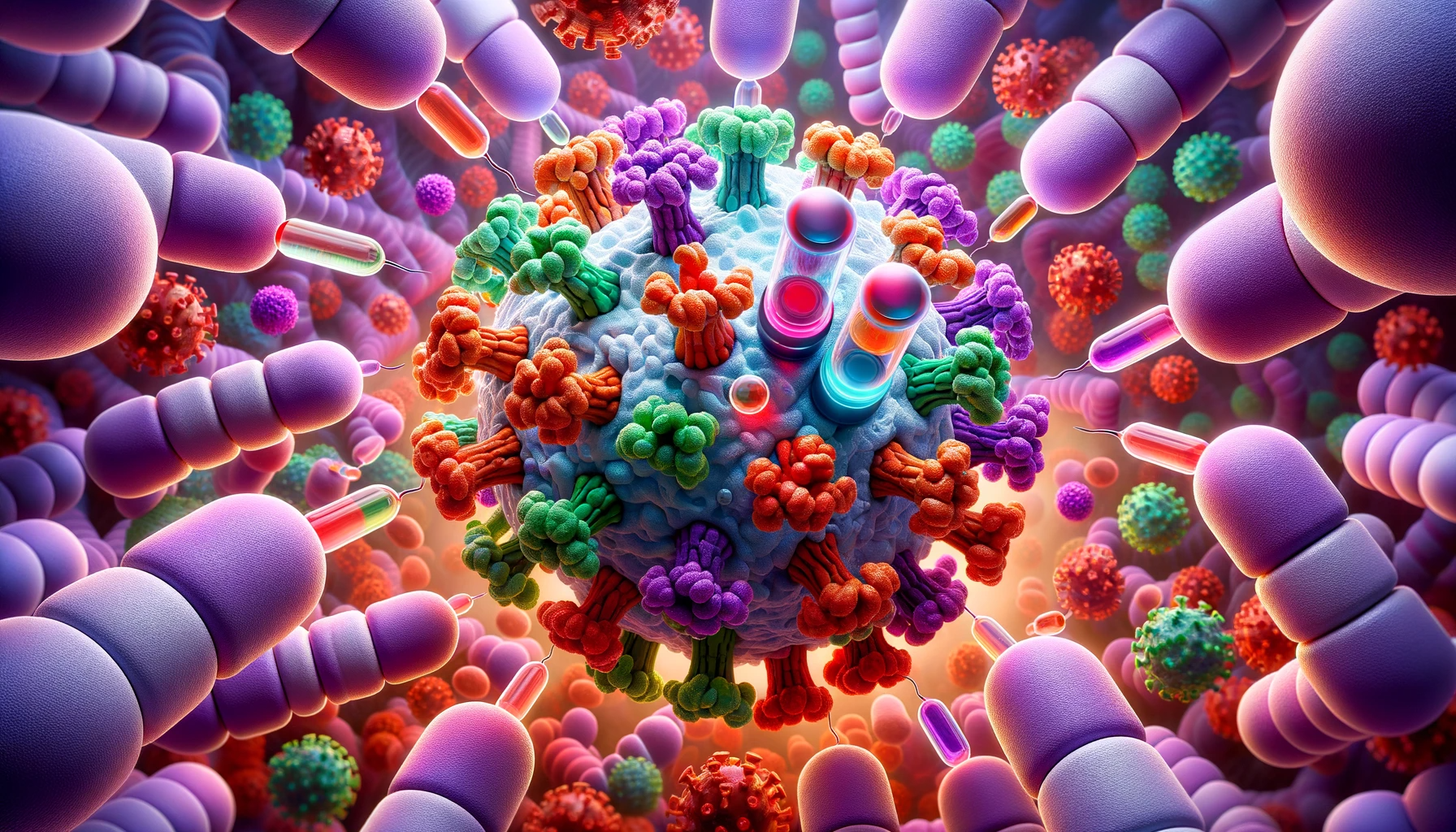In a recent study published in the journal Nature, researchers investigated the receptor affinity and antigenicity of severe acute respiratory syndrome coronavirus 2 (SARS-CoV-2) Omicron BA.2.86.
The coronavirus disease 2019 (COVID-19) pandemic has ended. Yet, the transmission and evolution of SARS-CoV-2 continue. Of late, infections have been predominantly due to the XBB.1.5 and EG.5.1 sub-variants. SARS-CoV-2 Omicron BA.2.86, a highly mutated sub-variant, was recently reported and is genetically distinct from existing variants.
 Study: Antigenicity and receptor affinity of SARS-CoV-2 BA.2.86 spike. Image Credit: Created with the assistance of DALL·E 3
Study: Antigenicity and receptor affinity of SARS-CoV-2 BA.2.86 spike. Image Credit: Created with the assistance of DALL·E 3
This sub-variant is as distant to its predecessor, BA.2, as the BA.1 variant is to the Delta variant, raising concerns of similar antibody evasion. More than 400 BA.2.86 sequences have been detected in 28 countries despite limited ongoing surveillance. A recent outbreak in a nursing facility in England suggests that the sub-variant is readily transmissible.
However, there is limited data on its pathogenicity. BA.2.86 harbors 34 additional mutations compared to BA.2. Although some of its mutations have been previously described, others have been rarely found. This extensive range of mutations in BA.2.86 is concerning, given its increased potential to evade infection- or vaccination-induced antibodies and therapeutic monoclonal antibodies (mAbs).
The study and findings
In the present study, researchers characterized the antigenicity of SARS-CoV-2 Omicron BA.2.86. They obtained serum samples from three cohorts. The first cohort included healthy individuals who received three doses of the monovalent vaccine, followed by two bivalent doses. The second and third cohorts included patients with a breakthrough infection with BA.2 and XBB after vaccination, respectively.
Vesicular stomatitis virus (VSV) pseudoviruses were generated to assess the antigenicity of the BA.2.86 spike. They developed two versions of its spike (BA.2.86-V1 and BA.2.86-V2) based on the absence or presence of the 1670V mutation, respectively. EG.5.1, XBB.1.5, and BA.2 pseudoviruses were also generated.
Pseudoviruses were tested for neutralization by sera from the three clinical cohorts. Both spike versions of BA.2.86 showed similar half-maximal inhibitory dilution (ID50) titers across cohorts, implying 1670V had no considerable effect. BA.2 was the most sensitive to serum neutralization across cohorts, while EG.5.1 was the most resistant.
BA.2.86 was two- and 1.9-fold more sensitive than EG.5.1 to neutralization by sera from the first and second cohorts, respectively. The sensitivity of BA.2.86, EG.5.1, and XBB.1.5 to neutralization by sera from the third cohort was similar. This was also confirmed by the neutralization of authentic BA.2.86 and EG.5.1 using the same sera, suggesting that exposure to XBB.1.5 could elicit an effective response against prevailing SARS-CoV-2 variants.
Next, the team tested the susceptibility of BA.2.86-V1 to 26 mAbs. EG.5.1 and XBB.1.5 were also tested for comparison. BA.2.86 was substantially or completely resistant to mAbs that target the N-terminal domain (NTD), receptor-binding domain (RBD) class 2 and 3 epitopes, and sub-domain 1 (SD1). The extent of evasion was larger than that by EG.5.1 and XBB.1.5.
Specifically, BA.2.86 was highly resistant to class 3 mAbs (Beta-54 and S309) and XGv051 (class 2 mAb), and evaded neutralization by SD1 mAbs that neutralized EG.5.1 and XBB.1.5. Notably, BA.2.86 was more sensitive to neutralization by most mAbs targeting class 4/1 and class 1 epitopes in inner RBD, compared to EG.5.1.
Next, the researchers synthesized genes for BA.2.86’s 34 mutations in the BA.2 background and generated corresponding pseudoviruses to re-examine neutralization by mAbs. They found that H245N substitution conferred resistance against C1520, an NTD-directed mAb. Likewise, the E554K substitution was responsible for evading neutralization by all SD-1 mAbs in the panel.
F486P and N460K mediated resistance to some RBD-directed class 1 and class 2 mAbs, while several others compromised the activity of RBD class 3 mAbs. In addition, the team identified two new mutations (I332V and S50L) and two known mutations (R493Q and R403K) that conferred sensitization. The remainder of new mutations in BA.2.86 had minor or no impact on antigenicity.
Finally, the team used surface plasmon resonance to assess the receptor affinity of the BA.2.86 spike, along with spikes of EG.5.1, BA.2, and XBB.1.5 variants. The affinity of EG.5.1 and XBB.1.5 spikes to angiotensin-converting enzyme 2 (ACE2) was comparable and only modestly greater than that of the BA.2 spike. By contrast, both spike versions of BA.2.86 demonstrated more than two-fold increased binding affinity.
Conclusions
Taken together, the SARS-CoV-2 BA.2.86 variant did not show higher resistance to neutralization by human sera than the EG.5.1 and XBB.1.5 variants. Besides, the variant was slightly more sensitive to neutralization than EG.5.1. These results starkly contrast findings from a Swedish study that observed BA.2.86 to be more resistant than XBB sub-variants.
This discrepancy might stem from the differences in SARS-CoV-2 infection or vaccination histories. The BA.2.86 spike also exhibited remarkably high receptor affinity. Overall, it will be crucial to delineate the underlying discrepancy given that higher resistance to neutralization may confer the variant an advantage to spread in the population; thus, continued surveillance is warranted.